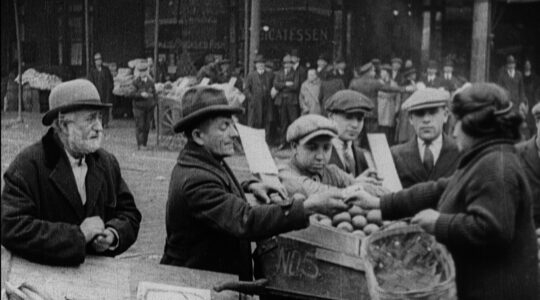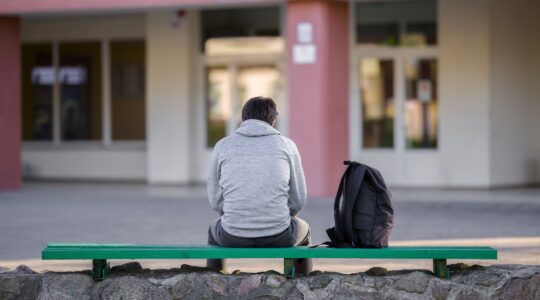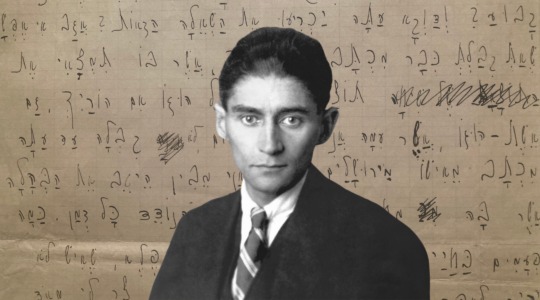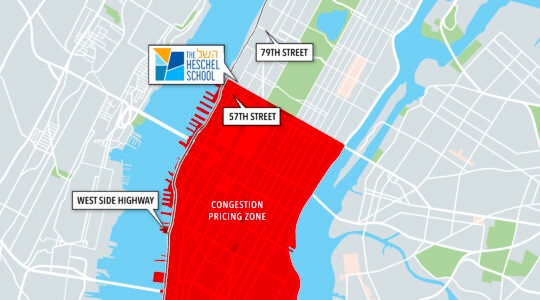Rabbi Haskel Lookstein is on the phone to another rabbi, trying to get him to help process “some wonderful candidates for conversion” the following Sunday. The Israeli chief rabbinate had pushed for narrower straits for converts to pass through, and the Rabbinical Council of America, Rabbi Lookstein’s group, went along with it.
“I have a responsibility,” says Rabbi Lookstein after hanging up the phone, “to work within the system. I’ve done hundreds of conversions in the last 50 years, and I don’t want their conversions to be questioned. But I also have a responsibility to the [American Jewish] community, to create a system that is inclusive rather than exclusive, that is user-friendly rather than intimidating.”
One might think Rabbi Lookstein is too old for this, at 76 and on the eve of his 50th anniversary in the pulpit, but he still is as sprightly as ever. Rebels and establishment, everyone wants him on their side. He’s become a rabbinic Jiminy Cricket, the great conscience of Modern Orthodoxy. He sort of dresses like Jiminy, too: Top hat, morning coat and striped trousers every Shabbat, his community’s tradition.
“After Shavuot, it’s summertime,” he says with a twinkle, “and we dress very casually, a three-piece black suit with a gray tie.” He’s just as comfortable dressing like the “tennis pro” he jokes about being, straight-faced, at the old Camp Massad in the Poconos.
In his book-lined office, along with memorabilia from Giants quarterbacks and happy nights at Shea Stadium, is an old photo of Rabbi Lookstein with his father and pulpit predecessor, Rabbi Joseph Lookstein, the two of them laughing in a Ramaz classroom, the school the elder Rabbi Lookstein founded in 1937. The school was named by Reb Joseph for his grandfather-in-law and pulpit predecessor, Rabbi Moses Zevulun Margolies, known by his Hebrew acronym, “the Ramaz.”
From the Ramaz to Reb Haskel, the Kehilath Jeshurun pulpit has been in the family for 102 years, since 1906, when the large and handsome chapel first opened its doors on East 85th Street.
The young Haskel studied the shul the way he studied the Giants in that other cathedral at Coogan’s Bluff. In the 1940s and ‘50s he kept a shul scorecard, “noting the attendance, the weather, my father’s sermon, and whether there was a special occasion. We had 220 people, 270, on a Shabbos morning, depending on the sermon. The sermon topic was a major draw. It no longer is.”
Something’s a draw. There are now more than 1,000 in the building most weeks, and last Rosh HaShanah, says the rabbi, there were 2,500 people davening in the various “KJ” minyans.
“My father wanted KJ to have the dignity and decorum of a Reform temple and the warmth of a shteibel. We never reached either extreme; the tilt was a little bit more to decorum in my father’s time and, in mine, a little bit more to shteibel warmth.”
It was different in those distant days. When Ramaz opened on 85th Street in 1937, for Haskel’s first grade, directly diagonal was the Turnerverein beer hall on Lexington Avenue, headquarters for the pro-Nazi German-American Bund. In the spring and summer of ‘38, on a nice night, you could see them marching down 86th Street.
“We never wore a kipa outside. I went to Columbia College and I never saw a kipa the whole time I was there. There was one guy who wore a hat.”
The elder Rabbi Lookstein would say, “We used to walk around like question marks. After 1967,” and Israel’s miracle victory, “we started walking like exclamation points.”
In the 1950s, at KJ and Ramaz, it wasn’t the way you walked, it was the way you danced. “Saturday night was a basketball game and a dance,” says the teen Haskel that still lives inside the man. “All the boys from [the all-boy yeshivas] came to meet the Ramaz girls.”
The Ramaz cheerleaders wore pleated skirts and saddle shoes, their arms akimbo when not pumping fists into the air. After the game, like teenagers in most of America, a boy held a girl’s waist, a girl slung her arms around his neck, while Debbie Reynolds, as “Tammy,” would wistfully sing, “I hear the cottonwoods whisperin’ above….”
What’s that you say, no mixed dancing in Orthodoxy?
“I actually learned how to foxtrot and rumba,” says Rabbi Lookstein, “in my freshman year at Ramaz, from Pearl Joseph, the women’s gym teacher.”
Then came 1958 and a crossroads. Ordained at Yeshiva University, only three of Reb Haskel’s 36 classmates went into the pulpit. There weren’t many jobs. The new rabbi was offered a pulpit in Detroit, but could he find a bride there? He was offered a job at the nascent Sephardic Temple in the Five Towns, but he wasn’t Sephardic. The only other job was as an assistant at KJ. Some warned him against taking what could have been a perilous position.
On June 14, 1958, Rabbi Haskel Lookstein adjusted his hat and entered KJ’s sanctuary, a room he knew as well as Christopher Robin knew the woods.
That was some year, 1958, long ago and far away. Hula-hoops were the biggest fad in America. The week of his first sermon, the radio was playing novelty songs, “Purple People Eater,” and “My Friend, the Witch Doctor,” and swoon songs, such as The Everly Brothers’ “All I Have To Do Is Dream.” Bel Airs, Biscaynes and Impalas were parked on the street; cars with V-8 engines, fins and chrome. Elizabeth Taylor was a black-and-white Maggie the Cat, and a Technicolor “Gigi” was in theaters that promised to be “air conditioned,” in a font of faux ice.
“I gave my first sermon on June 14,” remembers Rabbi Lookstein. “On June 21, at a Mizrachi Hatzair convention in the mountains, I told Audrey [Katz] I would like to be more than a friend.”
They dated at the opera and philharmonic. “We corresponded over the summer. She was with Herman Wouk in the Virgin Islands, tutoring his sons, reading the chapters of ‘This Is My God’ as he was writing them. We started going out that fall,” when Audrey was the Ramaz second-grade teacher, “and knew that this was it.”
Only a few years into his pulpit, Rabbi Lookstein was emerging as a major leader in the Soviet Jewry movement; in the national Synagogue Council; on the local Board of Rabbis; one of the few Orthodox leaders to defy the growing resistance to pluralism.
Rabbi Joseph Lookstein died in 1979. “We came back to the apartment and my mother said, ‘Haskel, you’ll sit there; that was dad’s seat.’ A couple of minutes later, she said, ‘Well, you’ll finally have a nice office.’ In two comments she took away all the guilt at my assuming my father’s position.”
When hearing of the death in 1983 of Mordecai Kaplan — the ex-Orthodox founder of Reconstructionist Judaism, a major Conservative influence, and anathema to most Orthodox Jews — “my mother called me up and said, ‘Haskel, are you going to put in an obituary?’”
“In those days we were still putting death notices in the Times. We stopped that and a lot of other synagogues stopped it because we stopped it,” to protest the Times coverage of Israel. “I take some pride in that. My mother reminded me, ‘He was an assistant rabbi in KJ,” back in Gertrude Lookstein’s grandfather’s time.
“I hadn’t thought of it. But I put in something to the effect of how our shul mourns the passing of a leader in Jewish thought and action, a leader and teacher of many Jews.’ I got so many notes and calls from Conservative rabbis praising me for having done this, and it wasn’t even my idea. It was my mother’s.”
The coin flipped in 1986, with the passing of Rav Moshe Feinstein, the leading halachic judge of the generation. “I was president of the New York Board of Rabbis — which Rav Moshe had signed an issur [prohibition] against,” as part of a ban on interdenominational activity, and yet “I thought putting in an obituary was the right thing to do.”
“One of my Orthodox colleagues called me up and said, ‘How can you do something like that?’ I said, ‘Look, I didn’t follow his issur, my father didn’t follow his issur. I just think the New York Board of Rabbis has to recognize the leading decisor of our day.’”
Rabbi Lookstein thought back on the decades: “I tried to be a mensch.”
A mensch, but not a marshmallow. When a Conservative leader charged that Modern Orthodoxy was being overtaken by negative “ultra-Orthodox values.” Rabbi Lookstein quickly responded, “I don’t pound away at the far left in Conservative Judaism and there certainly is a far left.”
When a Reform rabbi attacked Chabad, Rabbi Lookstein responded, “When I speak in shul I blast my own group. I do not talk about what Reform Judaism has done to deeply divide the American Jewish community. I do not blast [the then-Reform leader] Alex Schindler. I blast my own colleagues for not being ready to sit down and talk with Alex Schindler and work out a solution to our problems.”
After a half century, John Ruskay, CEO of UJA-Federation, says Rabbi Lookstein has become nothing less than “New York’s Rabbi,” not only for his school and shul but “his exemplary commitment” that has ensured a caring for the poor and a strengthening of “the New York Jewish community and the Jewish people in Israel. His service on behalf of the Jewish people is a precious gift.”
On June 14, Rabbi Lookstein will adjust his top hat and ascend the pulpit as he has since 1958.
Like a verse from “Gigi,” he must be wondering, “Am I getting old? … Oh no, not you. Ah, I remember it well.”
The New York Jewish Week brings you the stories behind the headlines, keeping you connected to Jewish life in New York. Help sustain the reporting you trust by donating today.




